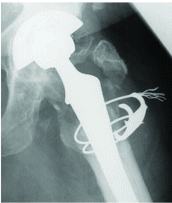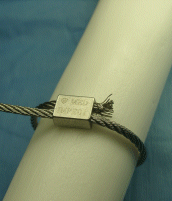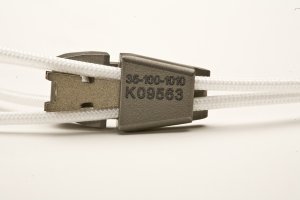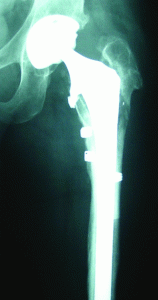Safety Product Category
Safety Cerclage Cables
During hip replacement and treatment of associated peri-prosthetic fractures, it is often necessary to hold the bone or fragments of bone together to create a stable environment for healing to occur. This is typically done with metal wires or cables using a technique called Cerclage (ser-klahzh.) A cerclage wire or cable is wound around a bone or bony fragments to hold them together to allow them to heal.
Although wire cerclage has had numerous applications in orthopedics as a primary method of fracture fixation it also has several disadvantages. Monofilament wires are prone to breakage. Multi-filament cables are subject to fatigue and fraying, releasing metallic particulate debris into the body. The metal wire or cable can break causing an interruption of the blood supply to the bone. The metal can also fray and fret causing tissue irritation and a source of bloodborne pathogen exposure to clinicians. Newer safety products are available that can help minimize this risk
SuperCable Iso-Elastic Cerclage
Imagine being an orthopedic surgeon and knowing that your patient’s artificial hip is worn out or loose. You have made the necessary incisions and are now ready to insert your hands into the open wound so that you can palpate around the hip to see the extent of the damage.

As you get ready to place your hands into the tissue, you think to yourself “I have a pretty good chance of getting stuck on a cabling wire that is surrounding the bone. Will I get stuck? What was this patient’s hepatitis or HIV status?”
What would you do? This is a real concern facing surgeons and their staff every time that they perform an orthopedic surgery.
During hip replacement and treatment of associated peri-prosthetic fractures, it is often necessary to hold the bone or fragments of bone together to create a stable environment for healing to occur. This is typically done with metal wires or cables using a technique called Cerclage (ser-klahzh.) A cerclage wire or cable is wound around a bone or bony fragments to hold together to allow them to heal.

Wire cerclage cables have several disadvantages and are prone to breakage. They are subject to fatigue and fraying, releasing metallic particulate debris into the body.

When trimmed to length the traditional cerclage cabling has many sharp ends that can tear gloves resulting in the loss of valuable operating room time to change gloves. It also can injure the clinician. Sharp metal cable ends can cause “wire stick” type injuries that pose a risk of disease transmission to surgeons and surgical staff. When a clinician is stuck by one of these wires it can tear the glove breaking the sterile barrier thereby placing the patient at risk of infection and exposing the clinician to blood-borne pathogens.

A new product can eliminate “wire stick” injuries to clinicians. The SuperCable Iso-Elastic Cerclage, is manufactured by Kinamed Inc. (Camarillo, CA, USA) and has been used in several thousand procedures worldwide since being introduced in 2003. This elastomeric polymer cable consists of a nylon core encased in a jacket of ultra-high-molecular-weight polyethylene (UHMWPE) braided fibers.
This combination of materials results in a flexible, soft cable that exhibits extremely high fatigue strength. Fatigue failure is primary mode of failure of metallic cerclage wires and cables.

The SuperCable system cables can be re-tensioned effectively when multiple cables are applied. This reduces the need to cut off and discard metal cables that have become loose after additional cables have been applied and tensioned. Over time, this feature will reduce the total number of cables required for a given procedure.

Post operative x-ray of four SuperCables wrapped around an allograft strut and hip prosthesis in revision hip replacement surgery. Note the SuperCables are radiolucent except for their locking clasp.
The SuperCable has fatigue strength superior to both metal wire and cables thereby reducing complications due to breakage. It also eliminates cable-generated metal particle debris that has been shown to greatly increase wear in adjacent total joints.
The cables are easy and quick to manipulate within the wound. Since the product is made of a polymer it contains no metal cable that can contact metallic implants and has no sharp ends to irritate patient tissue or cut surgeon’s gloves
